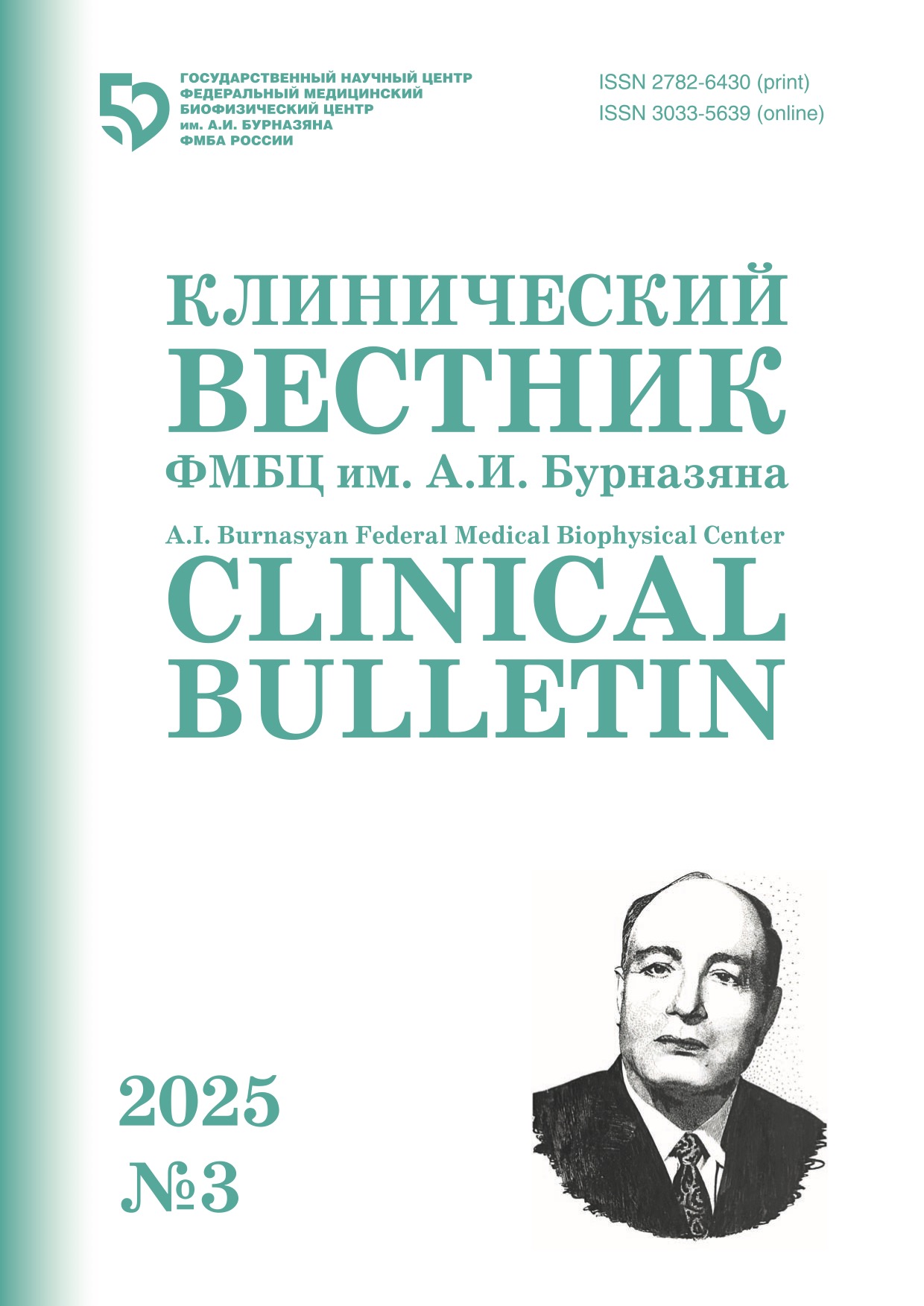A.I. Burnasyan FMBC clinical bulletin. 2023 № 1
N.I. Kurysheva, V.I. Naumova, S.G. Sergushev, O.A. Pererva, V.E. Kim
Intravitreal Injection in Practice: Review
A.I. Burnasyan Federal Medical Biophysical Center, Moscow, Russia
Contact person: Pererva Oksana: Oxana.pererva@yandex.ru
Abstract
Intravitreal injection is the method of administration of drugs into the eye by injection with a needle; the medication will be directly applied into the vitreous body. Compared to topical administration, this method is allows to deliver medications to the targeted site, as the needle can directly pass through the anatomical eye barrier (e.g. cornea, conjunctiva and lens) and dynamic barrier (e.g. tears and aqueous humor). It could also minimize adverse drug effect to other body tissues via the systemic circulation, which could be a possible risk for intravenous injection of medications. Intravitreal injection was first mentioned in a study in 1911, in which the injection of air was used to repair a detached retina. Intravitreal injection has become more common and a surge in the number of injections performed could be seen. The risk of complications can be minimized if all prescriptions are followed. This article presents in detail the intravitreal injection technique, pre-treatment and post-treatment precautions. Also in this article describes ocular drug delivery systems which provide controlled release for the treatment of chronic diseases, and increase patient’s and doctor’s convenience to reduce the dosing frequency and invasive treatment.
Keywords: Intravitreal Injection, age-related macular degeneration, diabetic macular edema, retinal vein occlusions
For citation: Kurysheva NI, Naumova VI, Sergushev SG, Pererva OA, Kim VE. Intravitreal Injection in Practice. Review. A.I. Burnasyan Federal Medical Biophysical Center Clinical Bulletin. 2023.1:17-23. (In Russian) DOI: 10.33266/2782-6430-2023-1-17-23
REFERENCES
- Danilichev V.F. Obosnovaniye i Effektivnost Primeneniya Proteoliticheskikh Fermentov pri Patologii Glaz (Kliniko-Eksperimentalnoye Issledovaniye) = Justification and Effectiveness of the Use of Proteolytic Enzymes in Eye Pathology (Clinical and Experimental Study): Avtoref. diss. … doct. med. nauk. 1983. P. 24 (In Russ.).
- Oh J.O., Minasi P., Grabner G., Ohashi Y. Suppression of Secondary Herpes Simplex Uveitis by Cyclosporine. Invest. Ophthalmol. Vis. Sci. 1985;26;4:494-500.
- Brown C.A. Penicillin in Ophthalmology: The Bacteriological, Experimental, and Clinical Evidence of Its Value, Including a Personal Series of 125 Clinical Cases. Br. J. Ophthalmol. 1946;30;3:146-167.
- Sorsby A., Ungar J. Intravitreal Injection of Penicillin; Study on the Levels of Concentration Reached and Therapeutic Efficacy. Br. J. Ophthalmol. 1948;32;12:857-864. DOI:10.1136/bjo.32.12.857.
- Voronin G.V., Budzinskaya M.V., Strakhovskaya M.G., Khalatyan A.S. Antibiotic Resistance in Patients after Serial Intravitreal Injections. Vestnik Oftalmologii = The Russian Annals of Ophthalmology. 2019;3:109-112 (In Russ.).
- Yin V.T., Weisbrod D.J., Eng K.T., et al. Antibiotic Resistance of Ocular Surface Flora with Repeated Use of a Topical Antibiotic after Intravitreal Injection // JAMA Ophthalmol. 2013. V.131, No. 4. P. 456-461. DOI:10.1001/jamaophthalmol.2013.2379.
- Miño De Kaspar H., Hoepfner A.S., Engelbert M., et al. Antibiotic Resistance Pattern and Visual Outcome in Experimentally-Induced Staphylococcus Epidermidis Endophthalmitis in a Rabbit Model. Ophthalmology. 2001;108;3:470-478. DOI:10.1016/s0161-6420(00)00545-5.
- Benoist d’Azy C., Pereira B., Naughton G., Chiambaretta F., Dutheil F. Antibioprophylaxis in Prevention of Endophthalmitis in Intravitreal Injection: A Systematic Review and Meta-Analysis. PLoS One. 2016;11;6:e0156431. DOI:10.1371/journal.pone.0156431.
- Ferguson A.W., Scott J.A., McGavigan J., et al. Comparison of 5% Povidone-Iodine Solution Against 1% Povidone-Iodine Solution in Preoperative Cataract Surgery Antisepsis: a Prospective Randomised Double Blind Study. Br. J. Ophthalmol. 2003;87;2:163-167. DOI:10.1136/bjo.87.2.163.
- Deramo V.A., Lai J.C., Fastenberg D.M., Udell I.J. Acute Endophthalmitis in Eyes Treated Prophylactically with Gatifloxacin and Moxifloxacin. Am. J. Ophthalmol. 2006;142;5:721-725. DOI:10.1016/j.ajo.2006.05.044.
- Miller D., Flynn P.M., Scott I.U., Alfonso E.C., Flynn H.W. Jr. In Vitro Fluoroquinolone Resistance in Staphylococcal Endophthalmitis Isolates. Arch. Ophthalmol. 2006;124;4:479-483. DOI:10.1001/archopht.124.4.479.
- Pożarowska D., Pożarowski P. The Era of Anti-Vascular Endothelial Growth Factor (VEGF) Drugs in Ophthalmology, VEGF and Anti-VEGF Therapy. Cent. Eur. J. Immunol. 2016;41;3:311-316. DOI:10.5114/ceji.2016.63132.
- Good T.J., Kimura A.E., Mandava N., Kahook M.Y. Sustained Elevation of Intraocular Pressure after Intravitreal Injections of Anti-VEGF Agents. Br. J. Ophthalmol. 2011;95;8:1111-1114. DOI:10.1136/bjo.2010.180729.
- Mansour A.M., Shahin M., Kofoed P.K., et al. Insight Into 144 Patients with Ocular Vascular Events During VEGF Antagonist Injections. Clin. Ophthalmol. 2012;6:343-363. DOI:10.2147/OPTH.S29075.
- SooHoo J.R., Seibold L.K., Kahook M.Y. The Link between Intravitreal Antivascular Endothelial Growth Factor Injections and Glaucoma. Curr. Opin. Ophthalmol. 2014;25;2:127-133. DOI:10.1097/ICU.0000000000000036.
- Dedania V.S., Bakri S.J. Sustained Elevation of Intraocular Pressure after Intravitreal Anti-Vegf Agents: What Is the Evidence? Retina. 2015;35;5:841-858. DOI:10.1097/IAE.0000000000000520.
- Neely D.C., Bray K.J., Huisingh C.E., Clark M.E., McGwin G.Jr., Owsley C. Prevalence of Undiagnosed Age-Related Macular Degeneration in Primary Eye Care. JAMA Ophthalmol. 2017;135;6:570-575. DOI:10.1001/jamaophthalmol.2017.0830.
- Brown D.M., Campochiaro P.A., Bhisitkul R.B., et al. Sustained Benefits from Ranibizumab for Macular Edema Following Branch Retinal Vein Occlusion: 12-Month Outcomes of a Phase III Study. Ophthalmology. 2011;118;8:1594-1602. DOI:10.1016/j.ophtha.2011.02.022.
- Ciulla T.A., Huang F., Westby K., Williams D.F., Zaveri S., Patel S.C. Real-World Outcomes of Anti-Vascular Endothelial Growth Factor Therapy in Neovascular Age-Related Macular Degeneration in the United States. Ophthalmol Retina. 2018;2;7:645-653. DOI:10.1016/j.oret.2018.01.006.
- Aref A.A.. Management of Immediate and Sustained Intraocular Pressure Rise Associated with Intravitreal Antivascular Endothelial Growth Factor Injection Therapy. Curr. Opin. Ophthalmol. 2012;23;2:105-110. DOI:10.1097/ICU.0b013e32834ff41d.
- Kiddee W., Montriwet M. Intraocular Pressure Changes in Non-Glaucomatous Patients Receiving Intravitreal Anti-Vascular Endothelial Growth Factor Agents. PLoS One. 2015;10;9:e0137833. DOI:10.1371/journal.pone.0137833.
- Xiong Q., Li Z., Li Z., et al. Anti-VEGF Agents with or Without Antimetabolites in Trabeculectomy for Glaucoma: a Meta-Analysis. PLoS One. 2014;9;2:e88403. DOI:10.1371/journal.pone.0088403.
- Campochiaro P.A., Marcus D.M., Awh C.C., et al. The Port Delivery System with Ranibizumab for Neovascular Age-Related Macular Degeneration: Results from the Randomized Phase 2 Ladder Clinical Trial. Ophthalmology. 2019;126;8:1141-1154. DOI:10.1016/j.ophtha.2019.03.036.
Conflict of interest. The authors declare no conflict of interest.
Financing. The study had no sponsorship.
Contribution. Article was prepared with equal participation of the authors.
Article received: 11.11.2022. Accepted for publication: 30.09.2022


